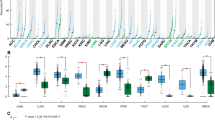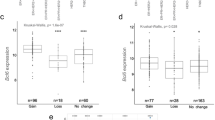Abstract
The purpose of this study is to explore the relationship between tumor hypoxia assessed by CA IX protein expression and loss of BRCA1 function in triple negative breast cancer (TNBC). Protein expression of CA IX and BRCA1 was evaluated by AQUA™ technology on two breast cancer cohorts: an unselected cohort of 637 breast cancer patients and a TNBC cohort of 120 patients. Transcriptional profiling was performed on FFPE samples from the TNBC cohort to evaluate a gene expression signature associated with BRCA1 mutation (van’t Veer et al., Nature 415(6871):530–536, 2002). CA IX is expressed in 7 % of the unselected breast cancer cohort and in 25 % of the TNBCs and is significantly associated with the triple negative phenotype. CA IX protein expression and BRCA1 protein expression are inversely correlated in both cohorts. Patients expressing high levels of CA IX show significantly worse overall survival (p = 0.02). Importantly, high CA IX protein expression occurs in patients who show the BRCA1 mutant signature and low levels of BRCA1 protein. These data suggest that elevated CA IX protein in TNBC is associated with a BRCA1 mutant signature and loss of BRCA1 function. CA IX may be a useful biomarker to identify triple negative patients with defective homologous recombination, who might benefit from PARP inhibitor therapy.




Similar content being viewed by others
Abbreviations
- FFPE:
-
Formalin-fixed paraffin-embedded
- HIF:
-
Hypoxia-induced factor
- PARP:
-
Poly(ADP-ribose) polymerase
- TNBC:
-
Triple negative breast cancer
- TMA:
-
Tissue microarray
- AQUA:
-
Automated quantitative analysis
- CA IX:
-
Carbonic anhydrase IX
- HR:
-
Homologous recombination
References
van’t Veer LJ et al (2002) Gene expression profiling predicts clinical outcome of breast cancer. Nature 415(6871):530–536
Nicoletto MO et al (2001) BRCA-1 and BRCA-2 mutations as prognostic factors in clinical practice and genetic counselling. Cancer Treat Rev 27(5):295–304
Venkitaraman AR (2002) Cancer susceptibility and the functions of BRCA1 and BRCA2. Cell 108(2):171–182
Johannsson OT et al (1997) Tumour biological features of BRCA1-induced breast and ovarian cancer. Eur J Cancer 33(3):362–371
Foulkes WD et al (2003) Germline BRCA1 mutations and a basal epithelial phenotype in breast cancer. J Natl Cancer Inst 95(19):1482–1485
Wang ZC et al (2004) Loss of heterozygosity and its correlation with expression profiles in subclasses of invasive breast cancers. Cancer Res 64(1):64–71
Silver DP et al (2010) Efficacy of neoadjuvant cisplatin in triple-negative breast cancer. J Clin Oncol 28(7):1145–1153
Feki A, Irminger-Finger I (2004) Mutational spectrum of p53 mutations in primary breast and ovarian tumors. Crit Rev Oncol Hematol 52(2):103–116
Melchor L et al (2008) Distinct genomic aberration patterns are found in familial breast cancer associated with different immunohistochemical subtypes. Oncogene 27(22):3165–3175
Han W et al (2008) DNA copy number alterations and expression of relevant genes in triple-negative breast cancer. Genes Chromosom Cancer 47(6):490–499
Tommiska J et al (2008) The DNA damage signalling kinase ATM is aberrantly reduced or lost in BRCA1/BRCA2-deficient and ER/PR/ERBB2-triple-negative breast cancer. Oncogene 27(17):2501–2506
Schneider BP et al (2008) Triple-negative breast cancer: risk factors to potential targets. Clin Cancer Res 14(24):8010–8018
Bindra RS et al (2005) Hypoxia-induced down-regulation of BRCA1 expression by E2Fs. Cancer Res 65(24):11597–11604
Harris AL (2002) Hypoxia—a key regulatory factor in tumour growth. Nat Rev Cancer 2(1):38–47
Rankin EB, Giaccia AJ (2008) The role of hypoxia-inducible factors in tumorigenesis. Cell Death Differ 15(4):678–685
Semenza GL (2003) Targeting HIF-1 for cancer therapy. Nat Rev Cancer 3(10):721–732
Airley RE et al (2003) GLUT-1 and CAIX as intrinsic markers of hypoxia in carcinoma of the cervix: relationship to pimonidazole binding. Int J Cancer 104(1):85–91
Russell J et al (2009) Immunohistochemical detection of changes in tumor hypoxia. Int J Radiat Oncol Biol Phys 73(4):1177–1186
Rafajova M et al (2004) Induction by hypoxia combined with low glucose or low bicarbonate and high posttranslational stability upon reoxygenation contribute to carbonic anhydrase IX expression in cancer cells. Int J Oncol 24(4):995–1004
Brennan DJ et al (2006) CA IX is an independent prognostic marker in premenopausal breast cancer patients with one to three positive lymph nodes and a putative marker of radiation resistance. Clin Cancer Res 12(21):6421–6431
Teicher BA, Lazo JS, Sartorelli AC (1981) Classification of antineoplastic agents by their selective toxicities toward oxygenated and hypoxic tumor cells. Cancer Res 41(1):73–81
Schreiber V et al (2006) Poly(ADP-ribose): novel functions for an old molecule. Nat Rev Mol Cell Biol 7(7):517–528
Fong PC et al (2009) Inhibition of poly(ADP-ribose) polymerase in tumors from BRCA mutation carriers. N Engl J Med 361(2):123–134
Domagala P et al (2011) PARP-1 expression in breast cancer including BRCA1-associated, triple negative and basal-like tumors: possible implications for PARP-1 inhibitor therapy. Breast Cancer Res Treat 127(3):861–869
Mendes-Pereira AM et al (2009) Synthetic lethal targeting of PTEN mutant cells with PARP inhibitors. EMBO Mol Med 1(6–7):315–322
Turner N, Tutt A, Ashworth A (2004) Hallmarks of ‘BRCAness’ in sporadic cancers. Nat Rev Cancer 4(10):814–819
Ossovskaya V et al (2010) Upregulation of poly(ADP-ribose) polymerase-1 (PARP1) in triple-negative breast cancer and other primary human tumor types. Genes Cancer 1(8):812–821
Yuan Y et al (2011) Novel targeted therapeutics: inhibitors of MDM2, ALK and PARP. J Hematol Oncol 4:16
Kluger HM et al (2004) Macrophage colony-stimulating factor-1 receptor expression is associated with poor outcome in breast cancer by large cohort tissue microarray analysis. Clin Cancer Res 10(1 Pt 1):173–177
Camp RL, Chung GG, Rimm DL (2002) Automated subcellular localization and quantification of protein expression in tissue microarrays. Nat Med 8(11):1323–1327
Zavada J et al (2003) Soluble form of carbonic anhydrase IX (CA IX) in the serum and urine of renal carcinoma patients. Br J Cancer 89(6):1067–1071
Rakha EA et al (2008) Expression of BRCA1 protein in breast cancer and its prognostic significance. Hum Pathol 39(6):857–865
Wilson CA et al (1999) Localization of human BRCA1 and its loss in high-grade, non-inherited breast carcinomas. Nat Genet 21(2):236–240
Al-Mulla F et al (2005) BRCA1 gene expression in breast cancer: a correlative study between real-time RT-PCR and immunohistochemistry. J Histochem Cytochem 53(5):621–629
Press JZ et al (2008) Ovarian carcinomas with genetic and epigenetic BRCA1 loss have distinct molecular abnormalities. BMC Cancer 8:17
Rastelli F et al (2010) Triple-negative breast cancer: current state of the art. Tumori 96(6):875–888
Turner NC et al (2007) BRCA1 dysfunction in sporadic basal-like breast cancer. Oncogene 26(14):2126–2132
Thompson ME et al (1995) Decreased expression of BRCA1 accelerates growth and is often present during sporadic breast cancer progression. Nat Genet 9(4):444–450
Dobrovic A, Simpfendorfer D (1997) Methylation of the BRCA1 gene in sporadic breast cancer. Cancer Res 57(16):3347–3350
Matros E et al (2005) BRCA1 promoter methylation in sporadic breast tumors: relationship to gene expression profiles. Breast Cancer Res Treat 91(2):179–186
Generali D et al (2006) Role of carbonic anhydrase IX expression in prediction of the efficacy and outcome of primary epirubicin/tamoxifen therapy for breast cancer. Endocr Relat Cancer 13(3):921–930
Pinheiro C et al (2011) GLUT1 and CAIX expression profiles in breast cancer correlate with adverse prognostic factors and MCT1 overexpression. Histol Histopathol 26(10):1279–1286
Beketic-Oreskovic L et al (2011) Prognostic significance of carbonic anhydrase IX (CA-IX), endoglin (CD105) and 8-hydroxy-2′-deoxyguanosine (8-OHdG) in breast cancer patients. Pathol Oncol Res 17(3):593–603
Hussain SA et al (2007) Hypoxia-regulated carbonic anhydrase IX expression is associated with poor survival in patients with invasive breast cancer. Br J Cancer 96(1):104–109
Weil MK, Chen AP (2011) PARP inhibitor treatment in ovarian and breast cancer. Curr Probl Cancer 35(1):7–50
Drew Y et al (2011) Therapeutic potential of poly(ADP-ribose) polymerase inhibitor AG014699 in human cancers with mutated or methylated BRCA1 or BRCA2. J Natl Cancer Inst 103(4):334–346
O’Shaughnessy J et al (2011) Iniparib plus chemotherapy in metastatic triple-negative breast cancer. N Engl J Med 364(3):205–214
Acknowledgments
Part of this study has been funded by the Susan G. Komen Grant (Komen KG090562).
Conflict of interest
D.L. Rimm is a stockholder in and consultant to HistoRx Inc., the exclusive licensee to the Yale owned AQUA technology. All the other authors declare that they do not have any competing interests.
Ethical standards
This project was performed in compliance with the relevant ethical standards in the US.
Author information
Authors and Affiliations
Corresponding author
Electronic supplementary material
Below is the link to the electronic supplementary material.
10549_2012_2232_MOESM1_ESM.ppt
Supplemental Fig. 1: Antibody validation of CA IX and staining examples for BRCA1 protein. The CA IX antibody was validated with Western Blot, showing expression of CA IX at the right molecular weights in A 431 and MDA MB 468 cell lines. A faint band is also present in MDA MB 453 cells. Immunofluorescent staining and AQUA analysis of CA IX protein on a TMA containing the same cell lines confirms positivity of these cell lines as assessed via IF (A). AQUA analysis of index TMAs shows excellent reproducibility of staining runs with an r2 of 0.98 (B). Representative staining images of CA IX on cell lines (C) and breast cancer samples (D) are shown as well. The BRCA1 antibody has been validated previously and representative staining samples are shown in E. (PPT 330 kb)
10549_2012_2232_MOESM2_ESM.ppt
Supplemental Fig. 2: Analysis of BRCA1 protein expression on the unselected breast cancer cohort and the TNBC cohort. BRCA1 protein expression was analyzed in a similar manner to CA IX expression. The distribution and reproducibility/heterogeneity is shown in A and C. In both cohorts BRCA1 does not show any prognostic value as assessed with survival analysis. To be able to perform Kaplan–Meier analysis both cohorts were binarized for low and high BRCA1 expression using the median BRCA1 score (B and D). However within the TNBC cohort BRCA1 protein expression is negatively correlated with nodal status, reaching statistical significance with a p value of 0.018 (E). (PPT 359 kb)
10549_2012_2232_MOESM3_ESM.pptx
Supplemental Fig. 3: Correlation of CA IX and BRCA1 protein expression and the BRCA1 mutant signature. The 3 panels of this figure show the same correlations as Fig. 4, illustrated as 2D plots. Panel A illustrates the relationship between BRCA1 AQUA scores and the BRCA1 signature, B between CA IX AQUA scores and BRCA1 AQUA scores and panel C shows the relationship between CA IX AQUA scores and the BRCA1 signature score. (PPTX 87 kb)
Rights and permissions
About this article
Cite this article
Neumeister, V.M., Sullivan, C.A., Lindner, R. et al. Hypoxia-induced protein CAIX is associated with somatic loss of BRCA1 protein and pathway activity in triple negative breast cancer. Breast Cancer Res Treat 136, 67–75 (2012). https://doi.org/10.1007/s10549-012-2232-0
Received:
Accepted:
Published:
Issue Date:
DOI: https://doi.org/10.1007/s10549-012-2232-0




